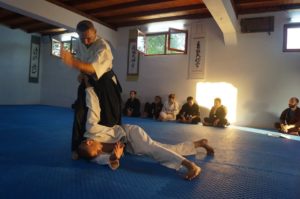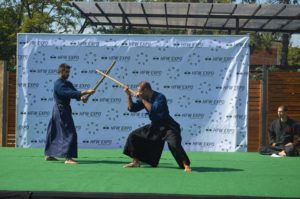This Saturday in the yard of the Homby Dojo of the Organization “Taiyou e no Michi”, the teacher Igor Dovezenski held a seminar on the topic of Santo Tonso no Kata. In the event took part five students of Bujinkan Macedonia who tried to explore the secrets of the school of Togakure ryu Ninjutsu.
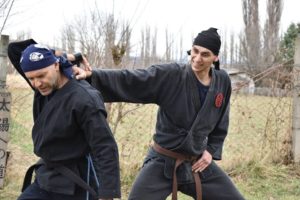
Because we are talking about a complex art, Dovezenski tried to at least scratch the surface of the techniques, without at the same time diving into the finer details, as he usually does during his teachings about the seminars.

During the closing of the seminar, all present unanimously declared that this school should be more frequently taught in the Homby Dojo, because the only way that could be done is surrounded by nature meaning somewhere the setting allows us both time and space.

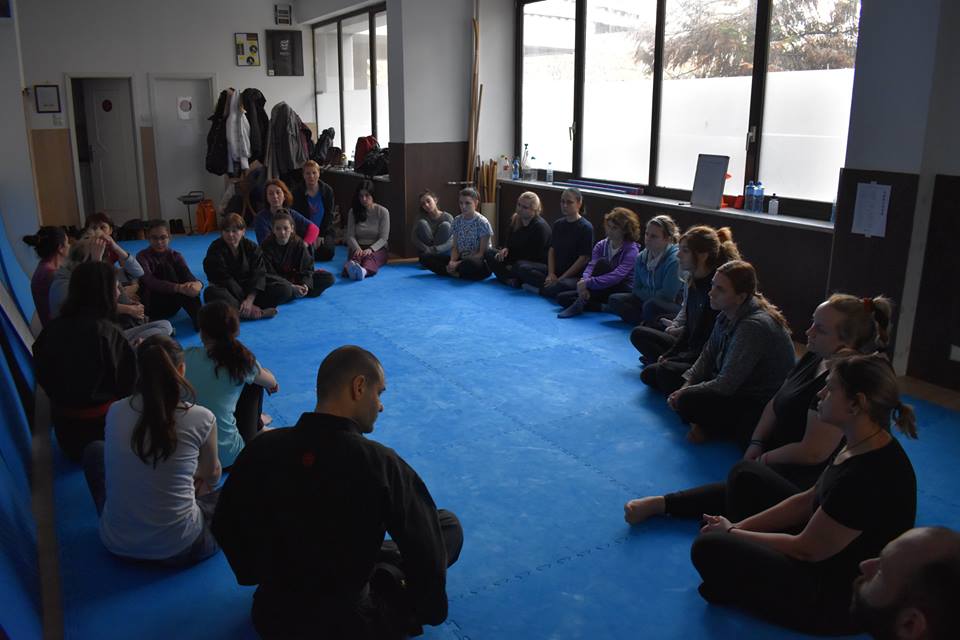 Eleven years in a row, the dojo Bujinkan Macedonia organized this event, and this year for the first time under the leadership of sempai Sanja Simonova, who together with the teacher Igor Dovezenski teaches techniques of self-defense from all kinds of situations. During the seminar, the participants had the opportunity to learn how to defend themselves from attacks with strikes, pinning to a wall, kicks, as well as situations when they find themselves on the ground. As support for Simonova and Dovezenski, always present were some of the older members of the dojo – Vladimir Antonovski, Mihail Drakalski and Filip Trajanovski.
Eleven years in a row, the dojo Bujinkan Macedonia organized this event, and this year for the first time under the leadership of sempai Sanja Simonova, who together with the teacher Igor Dovezenski teaches techniques of self-defense from all kinds of situations. During the seminar, the participants had the opportunity to learn how to defend themselves from attacks with strikes, pinning to a wall, kicks, as well as situations when they find themselves on the ground. As support for Simonova and Dovezenski, always present were some of the older members of the dojo – Vladimir Antonovski, Mihail Drakalski and Filip Trajanovski.  Besides the amazing companionship and incredible atmosphere, all the members of the fairer sex during the entire seminar kept the smiles on their faces, and for us that is the greatest sign of the success of the Workshop. Till next year.
Besides the amazing companionship and incredible atmosphere, all the members of the fairer sex during the entire seminar kept the smiles on their faces, and for us that is the greatest sign of the success of the Workshop. Till next year.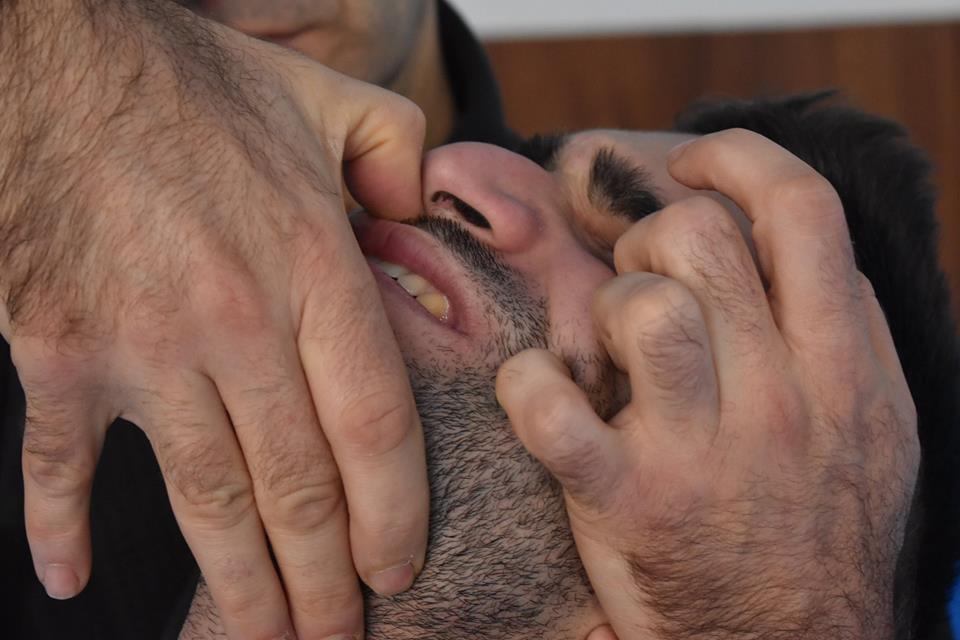 Around ten Warriors from Bujinkan Macedonia readily faced the pain that always is a companion when the topic is the study of the vital points of the body, and the smile on their faces never left. The Teacher Igor Dovezenski on the seminar had the time to teach about 18 vital points that when pressed or hit cause great pain in the attacker, which allows for a good defense during an undesirable situation.
Around ten Warriors from Bujinkan Macedonia readily faced the pain that always is a companion when the topic is the study of the vital points of the body, and the smile on their faces never left. The Teacher Igor Dovezenski on the seminar had the time to teach about 18 vital points that when pressed or hit cause great pain in the attacker, which allows for a good defense during an undesirable situation. 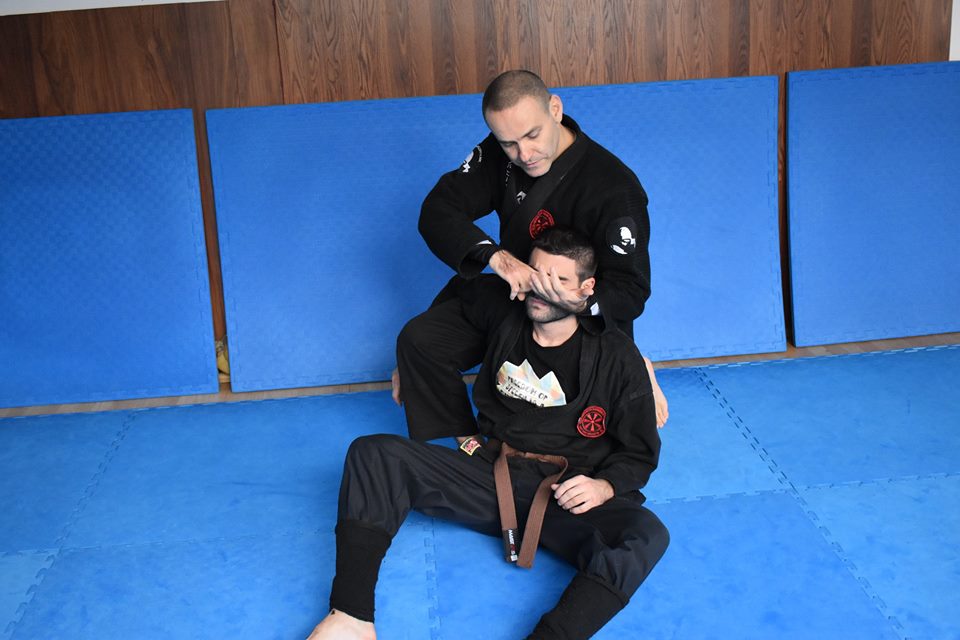 In the end, the participants in the event asked for it to again be held in the near future, but if possible for it to last two days, with the goal of accumulating greater knowledge about this Japanese art.
In the end, the participants in the event asked for it to again be held in the near future, but if possible for it to last two days, with the goal of accumulating greater knowledge about this Japanese art.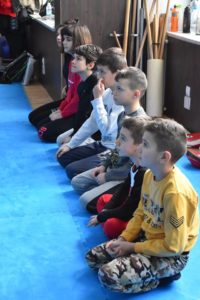 diminished the quality of the event, quite the opposite – we put in even more effort into transferring knowledge and rewarding the commitment of those who decided to take part.
diminished the quality of the event, quite the opposite – we put in even more effort into transferring knowledge and rewarding the commitment of those who decided to take part. The first seminar in the year 2019 brought about a strong sense of excitement even before it was announced, because it was known that two of our older members and regular participants in the seminar, will have the skills that they have gathered tested. In that direction, the teacher Dovezenski to his students Mihail Drakalski and Taki Gakovski showed two isolated locations in which they during five hours needed to show all their skills of winter survival which they had learned during their participation in the previous events. At the end of the day, sempai Gakovski successfully passed the test for the basics of winter survival, and with that became the second member of Bujinkan Macedonia that had succeeded in that. After the end of the seminar, Gakovski, together with shidoshi ho Opacik, shared their feeling on the internal Forum of “Taiyou e no Michi”. “Knowing that I will be alone, left on one of the hills of Orljak, at first I had a sense of fear. That feeling that I will run into wild animal I get every time that I think to go alone In nature. I don’t know why that happens to me, and that is why I keep writing in my head the kanji for ’empty’ or Mu – 無.During the entire previous week I kept thinking about the test. I kept rereading the old Reports from the seminars and read all my notes from all the events of this type. Before the start of Orljak climb, Sensei shared a few advice, and then lead the rest of our comrades in a different direction. Together with sempai Miki we took off in a direction opposite of that of the others, and after we shook hands and in a brotherly fashion wished luck to one-another, splitting up. Just as I climbed the hill, I run into a suitable place. A bolder on one side and a bush on the other. I thought to myself “I will stay here” and immediately got to working. I left my backpack and went to search for some dry grass
The first seminar in the year 2019 brought about a strong sense of excitement even before it was announced, because it was known that two of our older members and regular participants in the seminar, will have the skills that they have gathered tested. In that direction, the teacher Dovezenski to his students Mihail Drakalski and Taki Gakovski showed two isolated locations in which they during five hours needed to show all their skills of winter survival which they had learned during their participation in the previous events. At the end of the day, sempai Gakovski successfully passed the test for the basics of winter survival, and with that became the second member of Bujinkan Macedonia that had succeeded in that. After the end of the seminar, Gakovski, together with shidoshi ho Opacik, shared their feeling on the internal Forum of “Taiyou e no Michi”. “Knowing that I will be alone, left on one of the hills of Orljak, at first I had a sense of fear. That feeling that I will run into wild animal I get every time that I think to go alone In nature. I don’t know why that happens to me, and that is why I keep writing in my head the kanji for ’empty’ or Mu – 無.During the entire previous week I kept thinking about the test. I kept rereading the old Reports from the seminars and read all my notes from all the events of this type. Before the start of Orljak climb, Sensei shared a few advice, and then lead the rest of our comrades in a different direction. Together with sempai Miki we took off in a direction opposite of that of the others, and after we shook hands and in a brotherly fashion wished luck to one-another, splitting up. Just as I climbed the hill, I run into a suitable place. A bolder on one side and a bush on the other. I thought to myself “I will stay here” and immediately got to working. I left my backpack and went to search for some dry grass 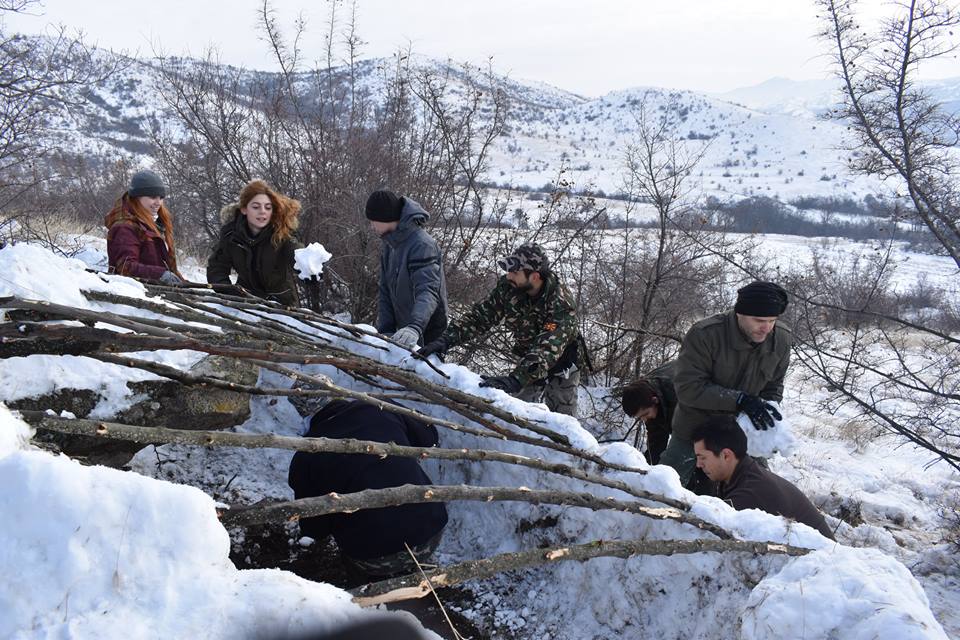 and twigs so I can get a fire going. Afterwards I hesitated a few times and thought of changing my location and climbing a bit higher, but I stayed put because I didn’t want to risk it. With the help of a small military shovel, I cleaned the area where I was supposed to stay and light a fire. I found it terribly hard and nearly impossible to light the branches. The moment a fire got going, it sputtered out because they were wet. Then I gave up on my plan and decided to leave the fire for latter, after which I decided to build a shelter. After I finished building, I started to gather some dry grass. I was lucky that above my location there was a lot of it. During those moments I was so motivated, I wasn’t even thinking about the thorns, or the pain from them. I used the advice of sempai Miki, and acted like I had to keep safe those closest to me – to make sure they survive. After i finished building, I got back to the fire. In the end after many attempts- I succeeded. Soon I noticed that in the hills it is very hard to keep the fire going, because everywhere there are small trees, and no big ones. That kept me going in all directions. The moment I would any dry branches I would run back to put them in the fire. That way I was always running until Sensei and my comrades came back. I was praying that they would come back sooner and I was kept going by my spirit of steel. Between me and sempai Miki there was not even a hint of rivalry, but of friendship and comradeship. Before it we constantly in contact, sharing ideas, notes and experiences, all with the goal of us both passing the test. In the end, I would like to thank Sensei and all the knowledge that he selflessly passes on to us.” – Taki Gakovski
and twigs so I can get a fire going. Afterwards I hesitated a few times and thought of changing my location and climbing a bit higher, but I stayed put because I didn’t want to risk it. With the help of a small military shovel, I cleaned the area where I was supposed to stay and light a fire. I found it terribly hard and nearly impossible to light the branches. The moment a fire got going, it sputtered out because they were wet. Then I gave up on my plan and decided to leave the fire for latter, after which I decided to build a shelter. After I finished building, I started to gather some dry grass. I was lucky that above my location there was a lot of it. During those moments I was so motivated, I wasn’t even thinking about the thorns, or the pain from them. I used the advice of sempai Miki, and acted like I had to keep safe those closest to me – to make sure they survive. After i finished building, I got back to the fire. In the end after many attempts- I succeeded. Soon I noticed that in the hills it is very hard to keep the fire going, because everywhere there are small trees, and no big ones. That kept me going in all directions. The moment I would any dry branches I would run back to put them in the fire. That way I was always running until Sensei and my comrades came back. I was praying that they would come back sooner and I was kept going by my spirit of steel. Between me and sempai Miki there was not even a hint of rivalry, but of friendship and comradeship. Before it we constantly in contact, sharing ideas, notes and experiences, all with the goal of us both passing the test. In the end, I would like to thank Sensei and all the knowledge that he selflessly passes on to us.” – Taki Gakovski 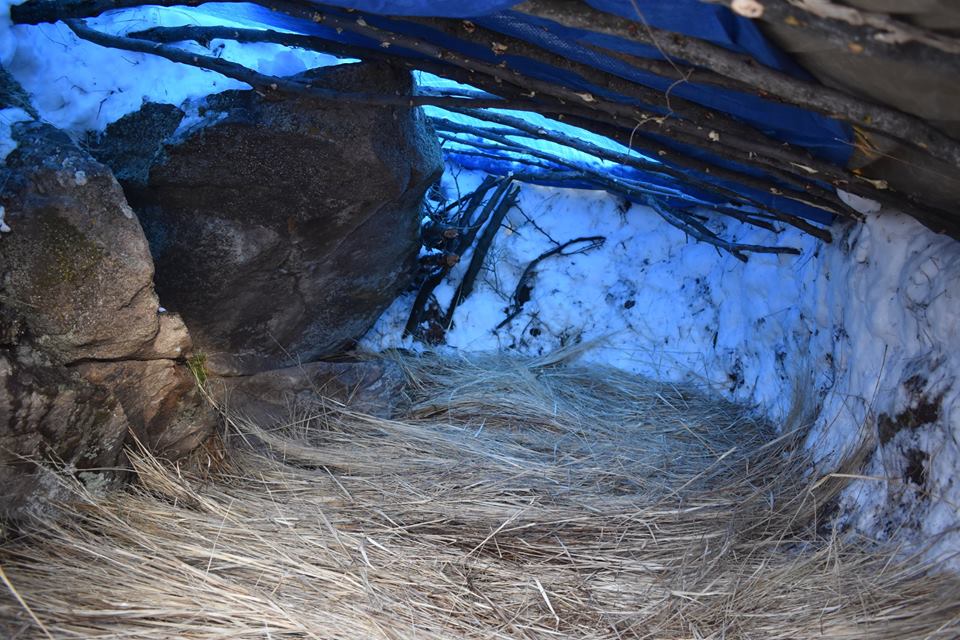 “We wrote the ninth in a row winter ninja training and again, as every year, we felt the marvelous atmosphere that is always present during this seminar. The day went by really fast, I believe that not even one monjin felt any difficulty, or any serious cold, although we were constantly out in the open. This time we created a huge sanctuary, big enough for 12 people, that was hermetically closed from all sides and very sturdily built. We got the fire going really fast, unlike previous years, and the same was kept going till the end of the training. Sensei this time again filed us with new knowledge, that are of crucial importance during this kind of events. His experience is huge and he always has something new to share with us. And about the testing of our sempais, I would like to congratulate both of them, although only one passed the exam. But we must not forget that every failure is an experience gained, but also a motivation for truing and working harder in the future. I don’t doubt that success will come on its own, but as always – sometimes sooner, sometimes latter.” – Marko Opacik
“We wrote the ninth in a row winter ninja training and again, as every year, we felt the marvelous atmosphere that is always present during this seminar. The day went by really fast, I believe that not even one monjin felt any difficulty, or any serious cold, although we were constantly out in the open. This time we created a huge sanctuary, big enough for 12 people, that was hermetically closed from all sides and very sturdily built. We got the fire going really fast, unlike previous years, and the same was kept going till the end of the training. Sensei this time again filed us with new knowledge, that are of crucial importance during this kind of events. His experience is huge and he always has something new to share with us. And about the testing of our sempais, I would like to congratulate both of them, although only one passed the exam. But we must not forget that every failure is an experience gained, but also a motivation for truing and working harder in the future. I don’t doubt that success will come on its own, but as always – sometimes sooner, sometimes latter.” – Marko Opacik

